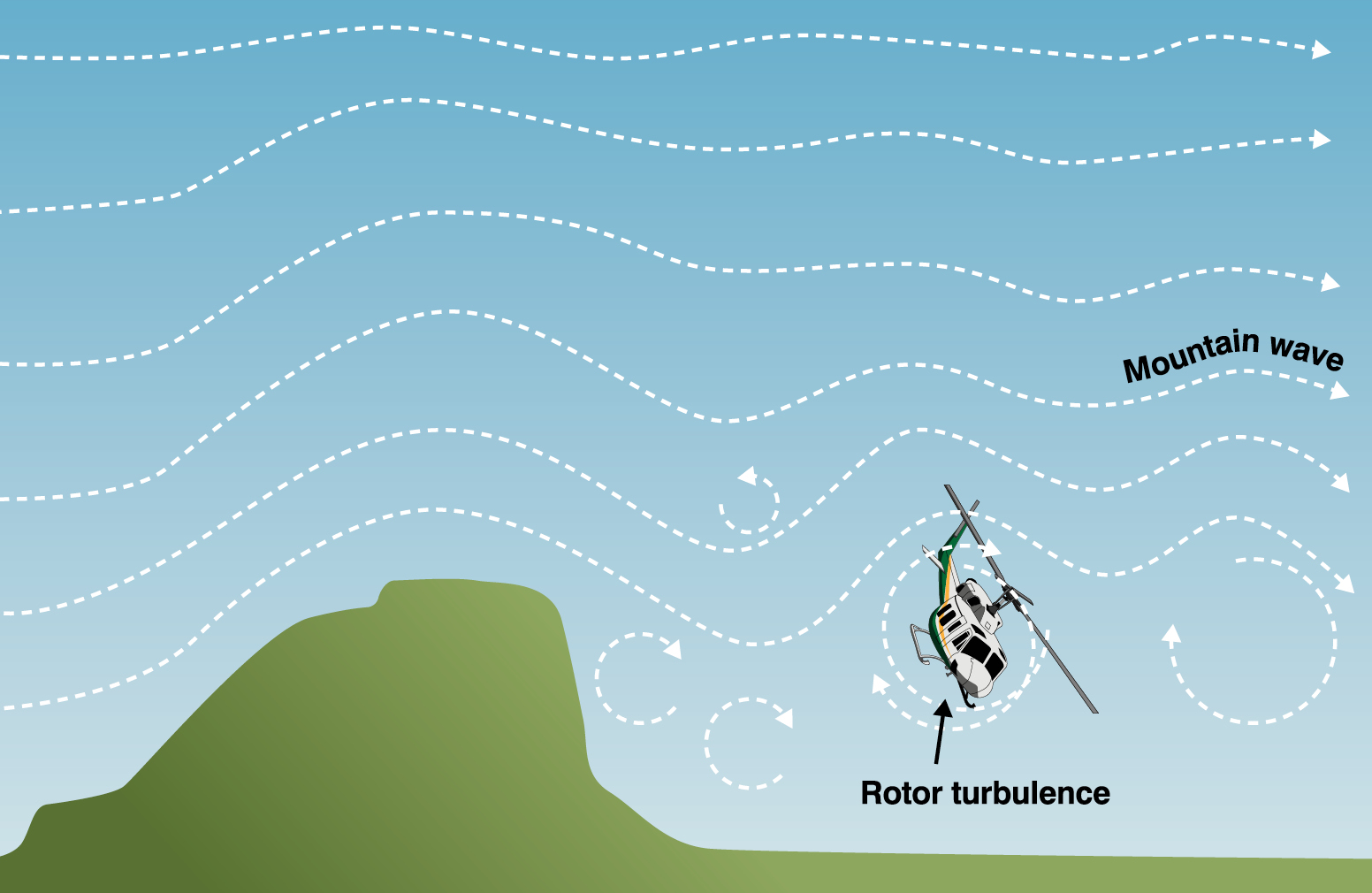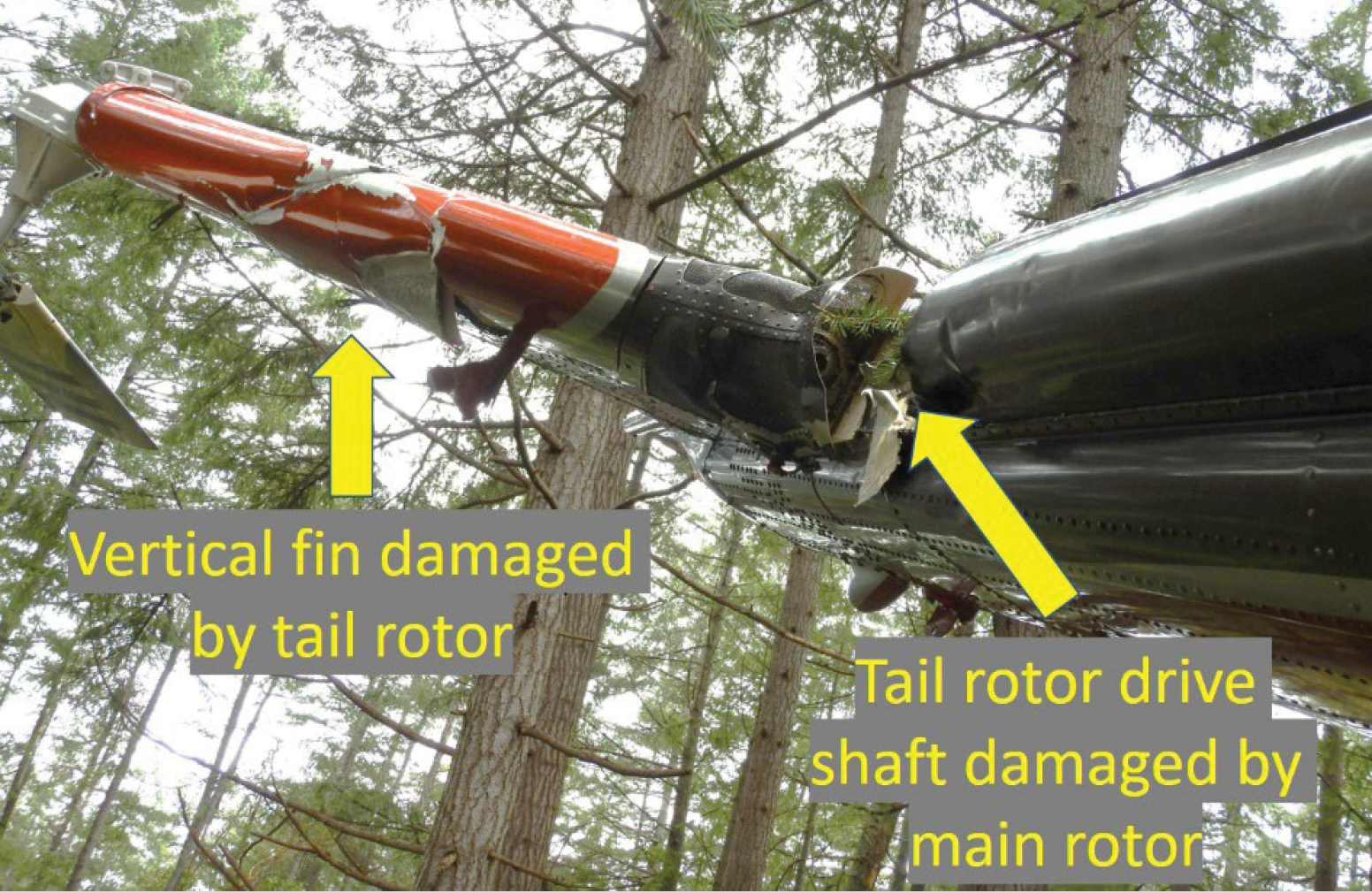The pilots of the Bell 212 knew there was forecast moderate turbulence with localised severe turbulence, mechanical turbulence and windshear. It was forecast to improve and there were already other helicopters out operating in the planned area on the other side of a nearby island.
So, the crew started the helicopter and tracked down the west coast of Canada towards Vancouver. Waves on the water indicated turbulence as bursts of air flowed down the mountain slopes and out over the water. They planned at 2,500 feet AMSL and slowed to turbulence penetration speed approaching an island with hill tops a few hundred feet below their cruise height.
Suddenly, the controls were momentarily pulled from the flying pilot’s hands and the helicopter pitched nose down and rolled to almost inverted. The second pilot grabbed the cyclic and both pilots pulled as hard as they could while the aircraft descended at 8,000 fpm. The controls were stiff and hard to move.
Together, both pilots managed to recover the aircraft at 1,000 feet. Several gauges in the instrument panel came free, falling back into the rear of the panel.
Miraculously, in a teetering rotor helicopter, they had managed to recover and were about to breathe a sigh of relief. However, as the adrenaline wore off, they realised the cyclic and pedal controls were hard to move. Now a hydraulic failure light came on, then an engine-out warning. Compound emergencies don’t happen – do they?
The pilots guided the helicopter to an island with a clear area to land. Unexpectedly, as the aircraft started its approach and decreased its airspeed, it started to yaw. Tail rotor failure?
The pilot closed the throttles and the helicopter descended the last 150 feet into trees. The helicopter tumbled through the trees, coming to rest upside down, as fuel slowly leaked from broken fuel lines under the cabin floor. The pilots helped each other out of their inverted seats.
Suddenly, the controls were momentarily pulled from the flying pilot’s hands and the helicopter pitched nose down and rolled to almost inverted.
The damage done
The Bell 212 is a teetering rotor head helicopter. The turbulence caused an extreme unusual attitude and, quite possibly, low or negative G. This meant the fuselage and mast moved relative to the rotor blade disc, so that the main rotor system came into contact with the tail boom. This severed the tail rotor drive shaft causing the loss of tail rotor thrust.
There were also witness marks where the mast had contacted the static stops on the main rotor blades. However, the pilots had one bit of luck this day as the mast did not separate from the helicopter.
At this stage, the helicopter had sufficient speed for its vertical fin to counter the main rotor torque effect.
The helicopter flew relatively straight, masking this problem, until it had to be slowed for landing.
Why the heavy and stiff controls? The accident investigation postulated the Bell 212 hydraulic system had air introduced into the system from the extreme unusual attitude. The gravity-fed hydraulic pumps momentarily ingested air as the fluid in the unpressurised hydraulic reservoirs no longer covered the system intake.
Why the sudden engine failure? One engine was found in the accident investigation to be not running when the aircraft crashed and no fault or cause could be identified. The extreme unusual attitude would have caused a rotor overspeed and the engines are designed to reduce fuel flow, hence power and, finally, reduce the torque on the rotor system to keep it within rotor RPM limits.
If the overspeed is too extreme, one of the engines could eventually shutdown due to the low fuel flow being scheduled.
The point here is if you think that this accident only has relevance to teetering head rotors and you are safe in your fully articulated or rigid rotor helicopter, then think again.
Consider whether your hydraulic system performance could be impaired or your engines would still be fully functional after a turbulence-inspired extreme unusual attitude. Consider also how unrestrained cargo moving around could create a foreign object debris (FOD) hazard or impact your ability to physically fly the helicopter. The investigation also found the number one fuel valve switch was broken and in the ‘off’ position – was this caused by unrestrained cargo coming into the cockpit, causing the engine to fail?

If you think that this accident only has relevance to teetering head rotors and you are safe in your fully articulated or rigid rotor helicopter, then think again.
Reading the clues
Although we can discuss why the helicopter became unflyable after encountering the turbulence, this is a weather accident. Avoiding this accident could have been achieved if the pilots had not flown that day. There are 2 parts to this – the weather and the decision to fly.
The forecast was for moderate, with localised severe, mechanical turbulence and low-level windshear. The trip was planned coastal, however, there was an inland mountain range over which a cold front was moving at the time. There were also islands, with terrain up to 2,500 feet, that needed to be crossed. The island topography was oriented 90 degrees to the prevailing wind direction.
A weather assessment for the accident investigation explained that the inland mountain topography, coupled with the strong pressure gradient of a passing cold front, would create strong and gusty outflow winds. These outflow winds would go down the valleys and inlets, towards where the accident occurred.
For mountain flying, you would usually expect turbulence and windshear to be found downwind of a topographical feature. The New Zealand CAA has some good guides on mountain flying which show how, as the wind speed increases, turbulence increases and rotor formation with associated turbulence occurs. The FAA provides guidance on mountain flying that says, when approaching a ridge or saddle crossing, the aircraft should be at least 1,000 feet above the terrain height 3 nm before the crossing point, to avoid mechanical turbulence.
With mountain ranges and perpendicular airflows, large waves can occur, called mountain waves. These are often associated with stable air masses that allow the standing waves to form. The turbulence and windshear may be associated with a roll or lenticular cloud but, equally, can have no visible indications of its presence.
Skyhooked, an Australian tragedy
Both Canada and New Zealand have large mountain ranges in colder areas where wind strength can be high. Some may think that mountain flying considerations may not be applicable in Australia. However, the Great Dividing Range, and mountains in Tasmania, South Australia and Western Australia, can have mountain waves – with the right wind direction and atmosphere – and their associated turbulence and windshear hazards.
A notable helicopter accident in Australia due to mechanical turbulence was the crash of a Bell 47 flown by the Skyhooks lead singer Shirley Strachan in south-east Queensland.
The Bureau of Meteorology (BOM) area forecast for the day of the accident indicated isolated severe turbulence and mountain waves below 9,000 feet. The Australian Transport Safety Bureau investigation concluded the helicopter probably encountered severe turbulence from mountain waves or rotors and the main rotor blades may have severed the tail boom.
Helicopters by their nature work at low levels. Strong winds at a large geographic feature can cause turbulence that is too strong for helicopters. Those with a sailing background will know that anchorages downwind of high terrain will experience large gusts of wind. These are often called ‘bullets’ and are the result of higher land masses funnelling surface winds through saddles and gullies. This funnelling can double the strength of the local wind.
The BOM will forecast areas of severe turbulence due to terrain. Further away from the terrain, conditions may be smoother – but be warned: getting close to or downwind of the terrain can lead to turbulence that could adversely affect your helicopter. It may occur with little visual sign.
Mental headwinds: biases and decisions

The pilots in the Canadian incident were going to be doing longline lifting for a high-voltage powerline project. They weren’t going to earn much money for the company if they didn’t fly, so the decision to fly could be a case of confirmation bias. This occurs where you notice, interpret or give greater credence to information or evidence that is consistent with a person’s existing beliefs.
In this case, the crew were keen to get airborne and believed this was the correct decision. They found evidence to support this decision from the cold front passing through with improving weather. The problem with this evidence was that it didn’t account for strong winds flowing down the mountain range from the passing cold front, into the area they were transiting.
Further evidence that supported the decision was knowledge that there were helicopters already flying in the destination area. The problem with this evidence was that those helicopters were on the upwind side of the tall island they had to cross.
The tall island wasn’t creating any turbulence in the upwind operations area. They saw evidence of turbulence in the wind disturbances on the water below them. Their decision to slow down to turbulence penetration speed was an action to confirm the decision of continuing with the sortie, instead of returning home.
In a perverse way, the GO–NO GO decision can provide positive decision-making feedback for a negative outcome. There would have been at least some self-imposed pressure to get airborne and start work – no one likes saying, ‘I can’t.’
When you make the GO decision, there is almost relief that you no longer must justify to yourself or the boss or the passengers about why you should say ‘NO GO’. You are on your way and everyone outside of the cockpit is happy. If you make a NO GO decision, there is a continued tension about why not or when can you or what happens now. The NO GO decision does not provide relief to the tension from everyone outside the cockpit and continues or even elevates the tension.
This incident could easily be repeated in the weather in Australia and even in a fully articulated or rigidrotor design. Severe turbulence is a challenge to all helicopters in the low-level environment. Whether you have the courage to make the correct GO–NO GO call on the weather could be life changing.





